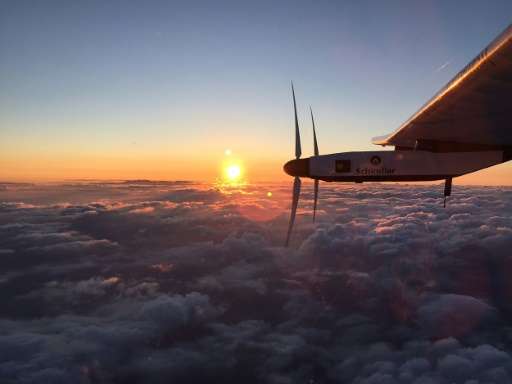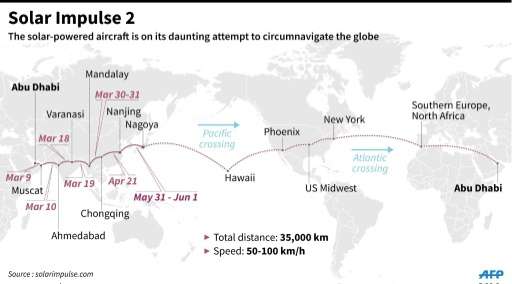Solar Impulse beats new record, but pilot 'tired'

A solar-powered aircraft flying from Japan to Hawaii on the most perilous leg of a round-the-globe bid has beaten the record for the longest solo flight, organizers said Thursday.
But they admitted that veteran Swiss pilot Andre Borschberg is absolutely exhausted after nearly four days' continuous flying, making the final 24 hours or so of flight particularly challenging.
"UPDATE #PACIFIC: @andreborschberg is tired. W/ turbulence at 8'000 feet & a cold front close, SITUATION IS DIFFICULT," said the latest tweeted update from the mission control center (MCC) of the pioneering Solar Impulse 2 aircraft.
"#MCC #solarTEAM is working hard to assess the situation & help @andreborschberg during this stressful period."
By 1630 GMT Thursday Solar Impulse 2 had traveled 84 percent of the way to the tropical US state, having flown 6,921 kilometers (4,300 miles) with 1250 km more to go, according to the project.
So far Borschberg has flown more than 94 hours—easily beating the previous longest solo endurance flight, by Steve Fossett who flew for 76 hours and 45 minutes in 2006. The whole trip from Japan to Hawaii was expected to take 120 hours.
The Swiss aviator is napping for only 20 minutes at a time to maintain control of the pioneering plane. He is equipped with a parachute and life raft, in case he needs to ditch in the Pacific.
The experimental solar-powered aircraft left Japan around 1800 GMT Sunday—the early hours of Monday local time—after spending a month in the central city of Nagoya.

The propeller-driven plane was originally scheduled to fly directly from Nanjing in China to Hawaii, but bad weather along the way forced a diversion to Japan that stretched to a month.
Borschberg is alone and entirely self-reliant in the 3.8-cubic-meter (134-cubic-foot) unpressurized cockpit.
Traveling at altitudes of more than 9,000 meters (29,500 feet), he has to use oxygen tanks to breathe and experiences huge swings in temperature throughout the day.
Solar Impulse 2 set off from Abu Dhabi earlier this year in a multi-leg attempt to fly around the world without a single drop of fuel.
It has 17,000 solar cells and on-board rechargeable lithium batteries, allowing it to fly through the night.
Its wingspan is longer than that of a jumbo jet but it weighs only 2.3 tonnes—about the same as a car.
© 2015 AFP





















